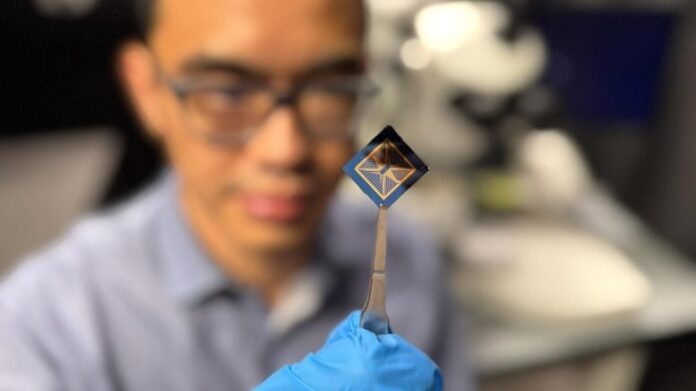Scientists built a device which sees and thinks as the brain. This opens doors to lightning fast robotics and safer autonomous cars.
RMIT University engineers have created a tiny brain-like device which can detect hand movements and store visual memories. It also processes information without the need for an external computer.
The innovation, called a neuromorphic gadget, mimics how the brain works. According to Professor Sumeet Walia the project’s principal researcher, this innovation could pave the road for ultra-fast processing in self-driving vehicles, intelligent robots and other smart technologies that interact more naturally with humans.
Analog Power for Energy Efficiency
Neuromorphic vision technology is analog-styled processing, similar to the way our brains work. This allows it to handle complicated visual tasks with greater energy efficiency.
“Neuromorphic systems are designed to use analogue processing similar to our brains. This can greatly reduce the energy required to perform complex tasks compared to digital technologies today,” said Walia. Director of the RMIT Centre of Opto-electronic Materials and Sensors.
A material with a memory
This work combines neuromorphic materials with advanced signal processing, led by Professor Akram al-Hourani who is the Deputy Director of COMAS. The device’s heart is made of molybdenum diulfide (MoS2), a metal compound only a few atoms in thickness.
The scientists demonstrated in their latest research how tiny defects on the atomic scale of MoS2 could be used to convert light into electrical signals. This is similar to the way neurons in the brain communicate and fire, allowing the device capture and process visual data in real time.
The Human Eye and Brain
This proof-of concept device mimics the ability of the human eye to capture light, and the brain’s capability to process this visual information. It allows it to sense changes in the environment instantly, and make memories without using huge amounts data and energy,” Walia stated.
Current digital systems are power-hungry and unable to keep pace with the increasing complexity and volume of data. This limits their ability to make “true” real-time decisions.
Research is published in Advanced Materials Technologies. Walia and Al-Hourani, PhD scholars at RMIT, are the corresponding authors. Mr. Thiha, a PhD student, is the first author. RMIT has filed for a provisional Patent for the work.
Seeing Motion, Making Memory
In experiments, the device detected changes to a waving hands’ movement without having to capture each frame. This is called edge detection and requires less processing power and data.
The device then stored the events as memories, just like a brain.
The team conducted experiments in the visible spectrum, building on their previous neuromorphic research in the ultraviolet domain . Thiha stated that they had demonstrated the ability of molybdenum diulfide, which is atomically thin, to accurately reproduce the leaky integrate and fire (LIF) behaviour of neurons. This is a fundamental building-block for spiking neural network.
Previous UV work involved only the detection, memory-making and processing of still pictures. Memory could be reset in both visible-spectrum devices and UV devices so that the devices are ready to perform their next task.
Lifesaving Speed and Real World Uses
This innovation could improve the response times of automated cars and advanced robotic systems, which can be crucial in dangerous and unpredictable environments.
Neuromorphic vision, which is many years away from being implemented in these applications, could detect changes to a scene almost immediately, without having to process a lot of data. This would enable a much quicker response, saving lives,” Walia said.
For robots that work closely with humans, such as in manufacturing or personal assistants, neuromorphic technologies could enable more natural interaction by recognizing and responding to human behavior quickly,” Al-Hourani stated.
Next Horizons and Scaling Up
Now the team is scaling up their proof-of concept single-pixel device into a larger pixel-array of MoS2-based MoS2-based devices.
To enable this scaling up, the Australian Research Council recently awarded a Linkage Infrastructure, Equipment and Facilities grant to the team. Walia explained that while our system mimics some aspects of the brain’s neural processing (especially in vision), it is still a simplified version.
We will optimize the devices for specific real-world tasks with more complex vision, and further reduce energy consumption.
Team plans to develop hybrid system that integrates their analogue tech with conventional digital electronics. Hybrid Future – Analog meets Digital
We see our work as complementary, not a replacement for traditional computing,” Walia said.
“Conventional system excel at many tasks while our neuromorphic technologies offer advantages for visual processing, where energy efficiency and real time operation are critical.”
Reference : “Photoactive Monolayer MoS2 For Spiking Neural networks Enabled Machine Vision Applications”, by Thiha Aung and Sindhu Priya Gridhar. Advanced Materials Technologies.
DOI: 10.1002/admt.202401677
Never miss a breakthrough: Join the SciTechDaily newsletter.





